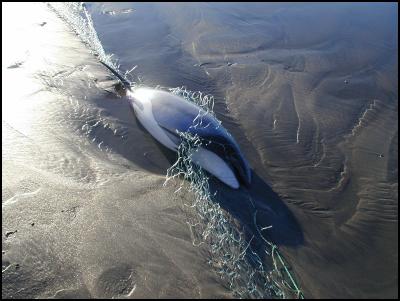Dolphin Deaths Over the Summer Period
Dolphin Deaths Over the Summer Period

Click for big version
1 May 2006
Dolphin Deaths Over the Summer Period
There have been a number of dolphin deaths this summer including the endangered Hector’s dolphin, found only in the coastal waters of New Zealand.
A significant number of the deaths have involved fishing practices. Dolphins have been caught and drowned in recreational and commercial set nets, as well as in trawl nets. There have been instances of dolphin bycatch throughout New Zealand’s coastal waters, and a variety of species have been caught, including dusky and common dolphins.
Of the nineteen reported Hector’s dolphin deaths this summer, eleven of those were confirmed by pathology reports as being caused by fishing practices, or were reported by fishers who caught them accidentally while fishing.
“We are extremely grateful to the fishers who have reported these incidents to the Department of Conservation,” said Research and Development General Manager, John Ombler.
“While it is unfortunate to lose any dolphins in this way, it is a legal requirement to report any dolphin deaths in fishing nets. It is also crucial that these incidents are reported to DOC so that we can understand any effects on the dolphin population and develop ways to prevent further deaths. I commend those fishers who stepped forward this summer and kept us informed.”
The Hector’s dolphin is the world’s smallest marine dolphin, as well as being the rarest marine dolphin on earth. It has an extremely low reproductive rate, with females only reaching breeding age at about seven or eight years. Each female produces one calf every three to four years. A subspecies of the Hector’s dolphin, the Maui’s dolphin exists on the West Coast of the North Island and it is now listed as critically endangered as classified by the International Union for the Conservation of Nature (IUCN). The South Island population remains classified as endangered.
“Maui’s dolphin is one of the few mammals found only in New Zealand. It is one of the world’s rarest dolphins making it is as precious a part of our natural heritage as the black robin or the kakapo.” said Mr Ombler.
The Government is working on a Threat Management Plan for Maui’s and Hector’s dolphins, run jointly by the Department of Conservation and the Ministry of Fisheries with guidance from an advisory group consisting of a range of stakeholders. Last week, an expert panel, involving a range of scientists and marine mammal experts, met to assess and evaluate threats to the Hector’s dolphins. The overall aim of the plan is to better define threats to all Maui’s and Hector’s dolphin populations and how to best manage those threats, including those posed by recreational and commercial fishing.
Dolphin deaths can be reported to the DOC HOTLINE (0800 362 468), or contact your local DOC office.
ENDS
Facts about dolphins in NZ:
Nine different species of dolphin are found around the New Zealand coast, including Hector's dolphin, one of the smallest and rarest in the world. This 1.4 metre dolphin is also known as the "downunder dolphin" because it is found only in New Zealand waters.
A North Island sub-species of
Hector's dolphin, called Maui's dolphin, lives off the west
coast of the North Island. There are thought to be less
than 150 of these dolphins left.
These are the world’s
smallest marine dolphins and are found only in New Zealand
waters.
Hector’s and Maui’s dolphins are mostly seen close to shore and in summer they frequent shallow waters less than 20 metres in depth. They are characterised by their distinctive grey, white and black markings, short snout and well-rounded black dorsal fin.
Dolphins use echolocation to find their food. They send out high frequency ‘clicks’ that bounce off surrounding objects and fish, giving the dolphins a detailed picture of their surroundings.


 Gordon Campbell: On Budget 2025
Gordon Campbell: On Budget 2025 Rainbow Wellington: Rainbow Wellington Concerned By Reports Of Increased Abuse
Rainbow Wellington: Rainbow Wellington Concerned By Reports Of Increased Abuse ACT New Zealand: David Seymour's Budget Day Speech 2025
ACT New Zealand: David Seymour's Budget Day Speech 2025 Government: Minister Of Finance’s Budget 2025 Speech
Government: Minister Of Finance’s Budget 2025 Speech The Prosperity Deal: Govt Budget Has No Plan For AI Job Loss – Citizens Launch The Prosperity Deal As The Only Workable Alternative
The Prosperity Deal: Govt Budget Has No Plan For AI Job Loss – Citizens Launch The Prosperity Deal As The Only Workable Alternative Greenpeace New Zealand: Greenpeace Braced For ‘Scorched Earth’ Budget From Govt
Greenpeace New Zealand: Greenpeace Braced For ‘Scorched Earth’ Budget From Govt NZ Police: Police Acknowledge Sentencing Of Donald Sarratt In Child Sexual Abuse Material Case
NZ Police: Police Acknowledge Sentencing Of Donald Sarratt In Child Sexual Abuse Material Case


